As the new Ligue 1 campaign starts, many are already hoping to see PSG finally get dethroned by the end of the season. However, Les Parisiens managed to win comfortably against Nimes with a convincing scoreline of 3-0 in their opening match, making those that aren’t exactly fans of the oil-rich club doubting as to whether or not they’ll be seeing new champions this season.
However, Thiago Silva and co. faced Rennes again in their second fixture, a stronger team overall who managed to defeat PSG three times in their last six meetings. The last two meetings particularly, have been quite tight with PSG and Rennes each got a vital win in the final of Trophee des Champions and Coupe de France respectively.
The match on Sunday was another proof that PSG should be more cautious this season as their competitors have now vastly improved not just in terms of player quality both as a team and as an individual, but also in the tactical side of the game. PSG may have players some levels above their opposition in terms of quality, but they were easily overcome via smart strategy and tactics employed by Rennes.
We’ll be taking a closer look at both team’s tactics in this tactical analysis.
Lineups
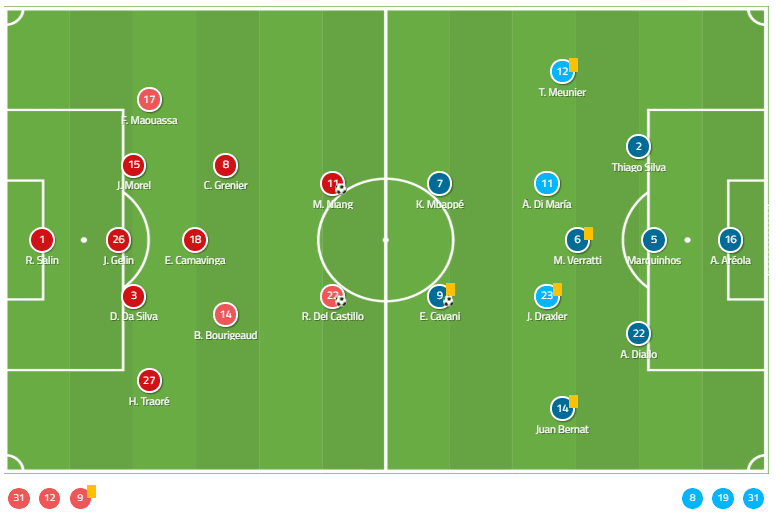
Rennes (5-3-2)
Stephan deployed his team once again in a 5-3-2 shape, however, there doesn’t seem to be much change in terms of tactics despite his team having to face a much more offensively aggressive PSG, having previously faced a rather defensive Montpellier. Not a lot of change in terms of personnel as well for Rennes. Benjamin Bourigeaud started the game ahead of James Lea-Siliki which shows Stephan’s desire to have a more defensively active midfielder in his side in this game. Romain Del Castillo replaced Flavien Tait who received a direct red card in his debut with Rennes the last time out.
Tuchel, on the other hand, opted for a three-man defence, taking the shape of 3-5-2 despite previously playing in a 4-3-3 system in their 3-0 win in the opening game against Nimes. Only two players were relegated to the bench. Thomas Meunier started ahead of Thilo Kehrer in this match, playing as the right wing-back. Maruqinhos moved deeper into the centre-back position having played as a defensive midfielder in the previous match. Angel Di Maria also started the game, replacing Pablo Sarabia. The Argentinian played as a right central midfielder in this game.
Starting XI: Salin – Traore, Da Silva, Gelin, Morel, Maouassa – Bourigeaud, Camavinga, Grenier – Del Castillo, Niang
Bench: Mendy, Boey, Nyamsi, Gboho, Johansson, Lea-Siliki, Siebatcheu
Coach: Julien Stephan
PSG (3-5-2)
Starting XI: Areola – Silva, Marquinhos, Diallo – Meunier, Di Maria, Verratti, Draxler, Bernat – Cavani, Mbappe
Bench: Bulka, Dagba, Gueye, Paredes, Sarabia, Choupo-Moting, Kouassi
Coach: Thomas Tuchel
Rennes’ defensive solidity
Stephan’s side were extremely solid defensively in this game, allowing PSG, who usually averaged around eight chances made per game, to create a maximum of five throughout the full 90.
Rennes defended mainly with a low block, with 10 men below the halfway line. However, they’d push forward when the ball was moved backward, moving the defensive block higher whilst keeping the shape very compact vertically.
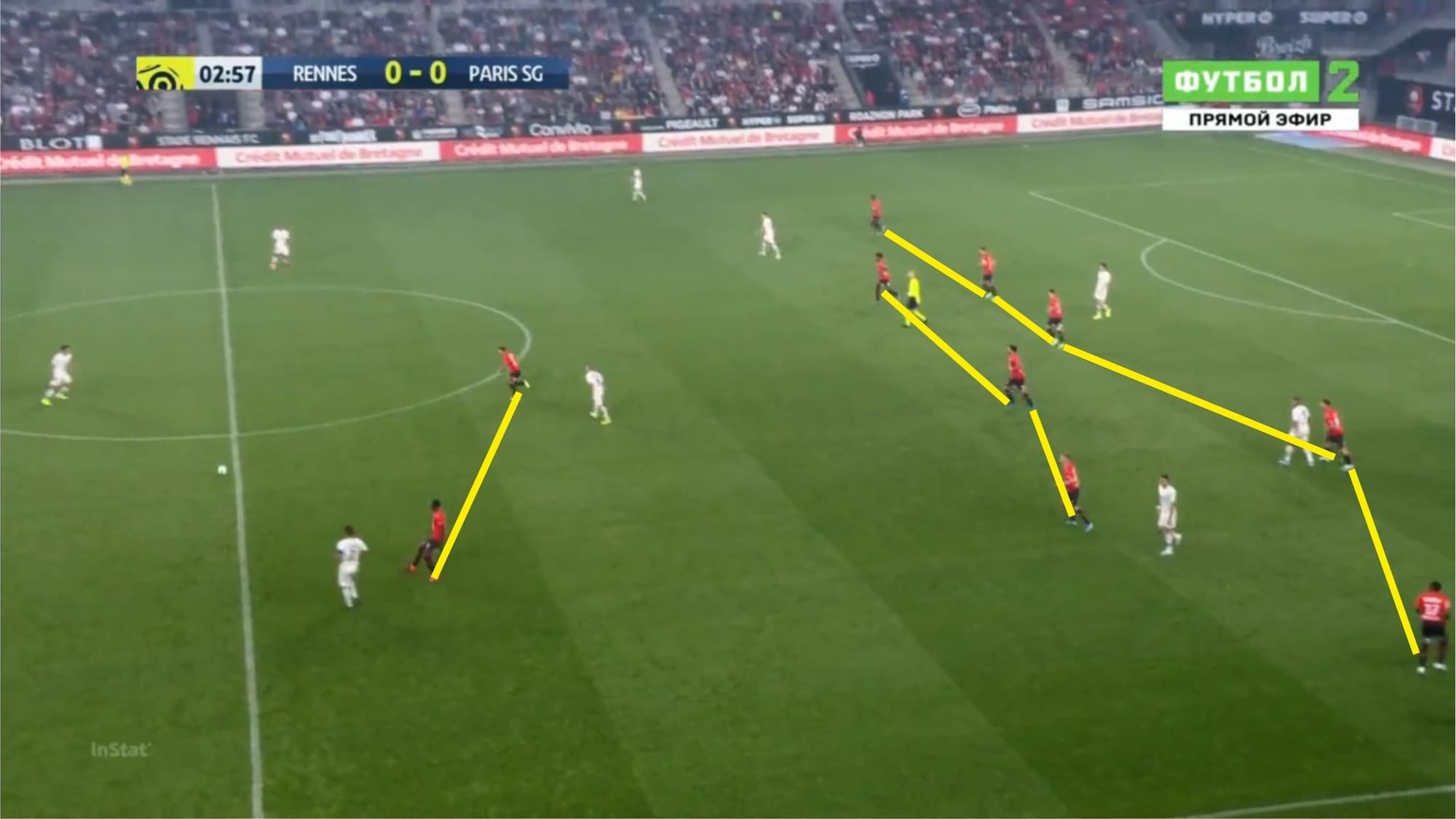
As you can see from the picture above, the distance between the midfield line and the defensive line was very small, Rennes compressed space and were very compact vertically. Due to this, PSG were having difficulties trying to play through the middle as there’s no space to exploit. This was also why PSG moved the ball a lot laterally, trying to find some space on the flanks or instead opted to loft the ball into the box, which in many cases were easily anticipated by the excellently-organized Rennes defence.
Despite mainly defending deep in their own half, Rennes also seemed to annoy PSG with their aggressive pressing upfront. When PSG were in the initial phase of build-up, Rennes’ block moved up and players start marking the options around the ball-carrier while one would press him (the ball-carrier) forcing him into making mistake.
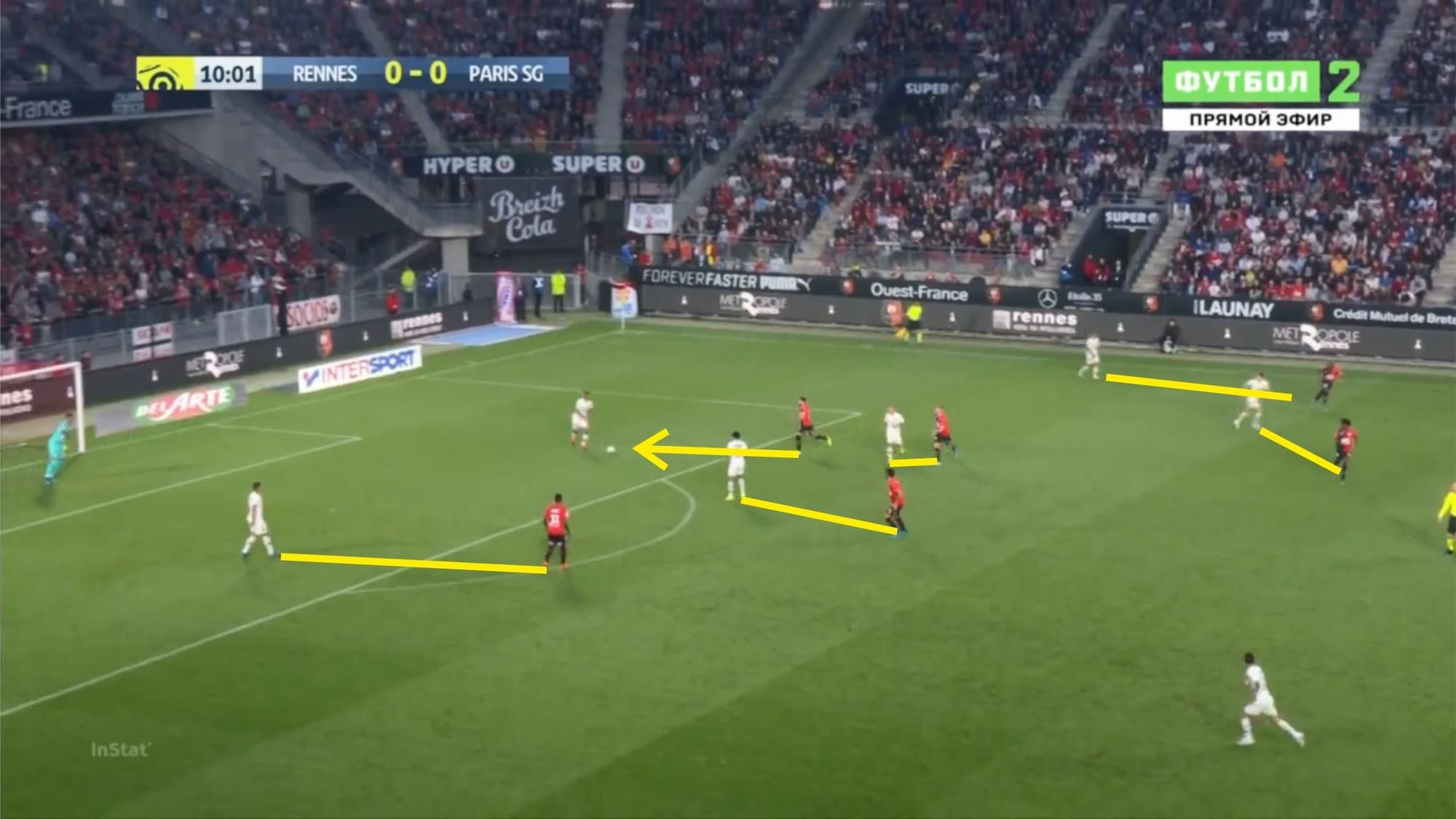
This often forced PSG, who preferred to build their play up from the back using mostly short-medium range passes, to play long.
This strategy, though was very much a nuisance for PSG, didn’t always work. This was due to the individual quality that the players have in PSG. The defenders would often try to dribble past the pressure and progress the ball forward through dribbling, not needing to pass the ball around to exit the pressure. However, there were several times in the game where Rennes managed to win the ball quite high above the halfway line and then breaking away quickly to create a goalscoring chance in the final third.
PSG’s attacking approach nullified
As usual, Tuchel’s side started the game with attacking mentality, looking to score a goal every time they have the ball. However, their aggressive approach in attack was not functioning as it should be against Rennes.
PSG built their play up from the back exchanging mostly short passes and using medium-range passes occasionally. A lot of their passes were ground passes and they seemed to try to progress through the middle and breakthrough centrally. However, as explained previously in this tactical analysis, these were made not possible due to Rennes’ extremely compact and organized low-blocking defence.
Though dominating most of the possession throughout the game, PSG were not able to create a lot of chances. A lot of their passes were lateral passes rather than vertical and a lot of their vertical passes seemed to be anticipated and dealt with by Rennes’ defence. PSG were unable to progress the ball into dangerous areas or to find gaps to exploit in Rennes’ defence. PSG’s defenders may have made a lot of touches and passes but those seemed to amount to nothing.
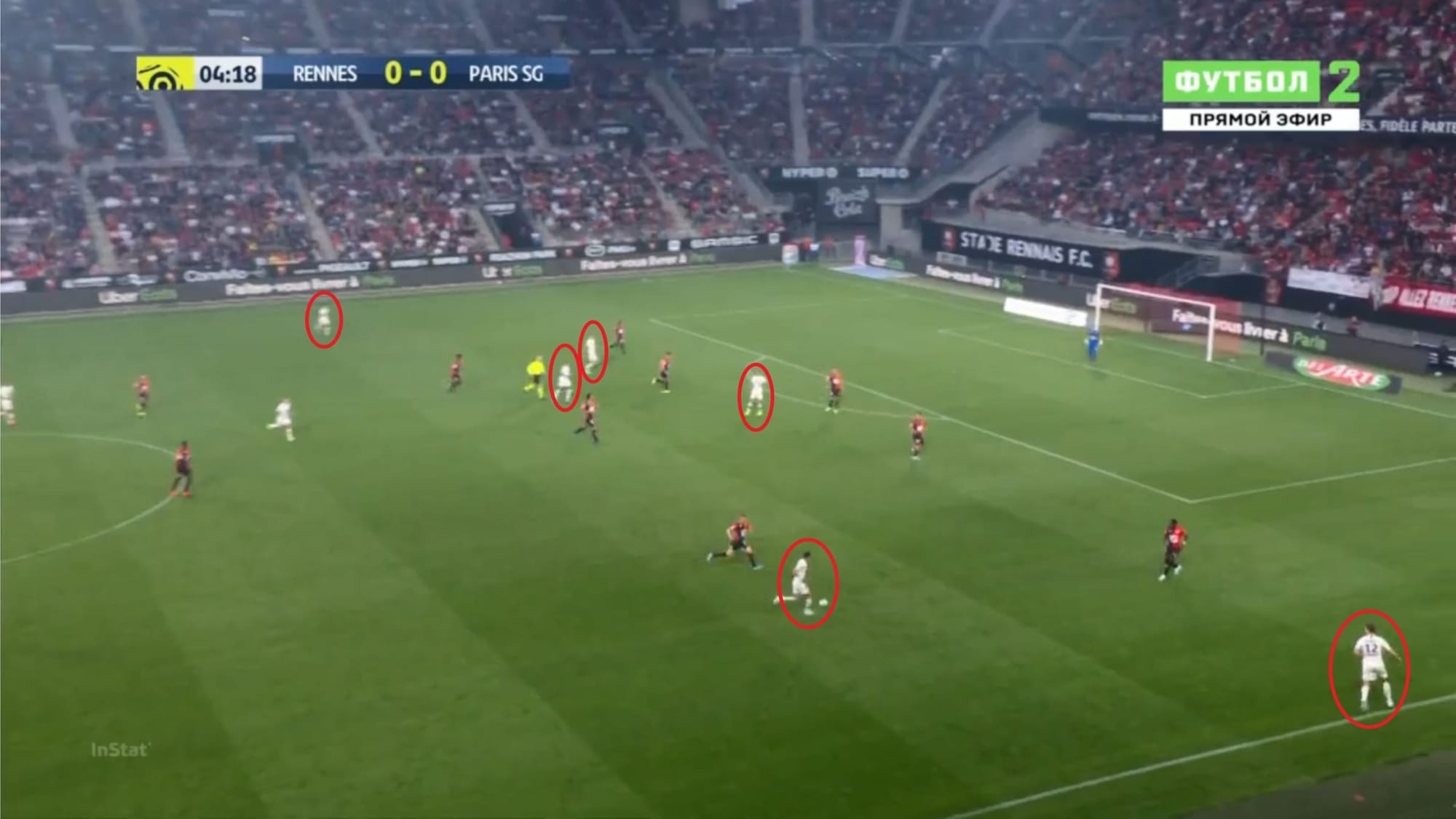
PSG tried to throw six men upfront, making their attacking shape look like a 3-1-6. The three defenders stayed behind while Marco Verratti acted as the pivot, receiving and distributing the ball. The Italian playmaker didn’t seem to hold his position though as he can be seen marauding forward as well to add the attacking number for PSG. In that case, Marquinhos would step forward to anticipate and destroy the opposition’s attempt to break in the middle of the field.
Both wing-backs would push higher and wider in order to stretch the defence. Di Maria and Julian Draxler sat mostly in the half-space, but both have different tendencies in the game. While the Argentinian often sat quite high, he often dropped deep to link up. After receiving the ball, Di Maria tends to cut inside with the ball and then deliver a diagonal pass into the box rather than dribbling the ball wide and then continuing down his flank (or giving the ball to Meunier). A bit different than Draxler who seemed to sit a bit lower and often received the ball Verratti before continuing down his side of flank, either via progressive dribbling or giving the ball to Mbappe upfront.
Mbappe seemed to be quite flexible in his positioning and movements on and off the ball in this game. He can be seen roaming wide a lot of time, allowing Bernat to make an underlapping run or driving inside the box with the ball. Cavani, on the other hand, was often found centrally and rarely roams out of his designated spot. The number of players surrounding the Uruguayan striker and the compactness of the defence prevented his teammates from being able to link up with him at the edge of the box.
PSG’s defensive weakness exploited
The French defending champions were also very intense and aggressive in defence. They blocked and pressed high, making it hard for the opposing team to build up as well as trying to win the ball from as high up the pitch as possible. As you can see from the picture below.
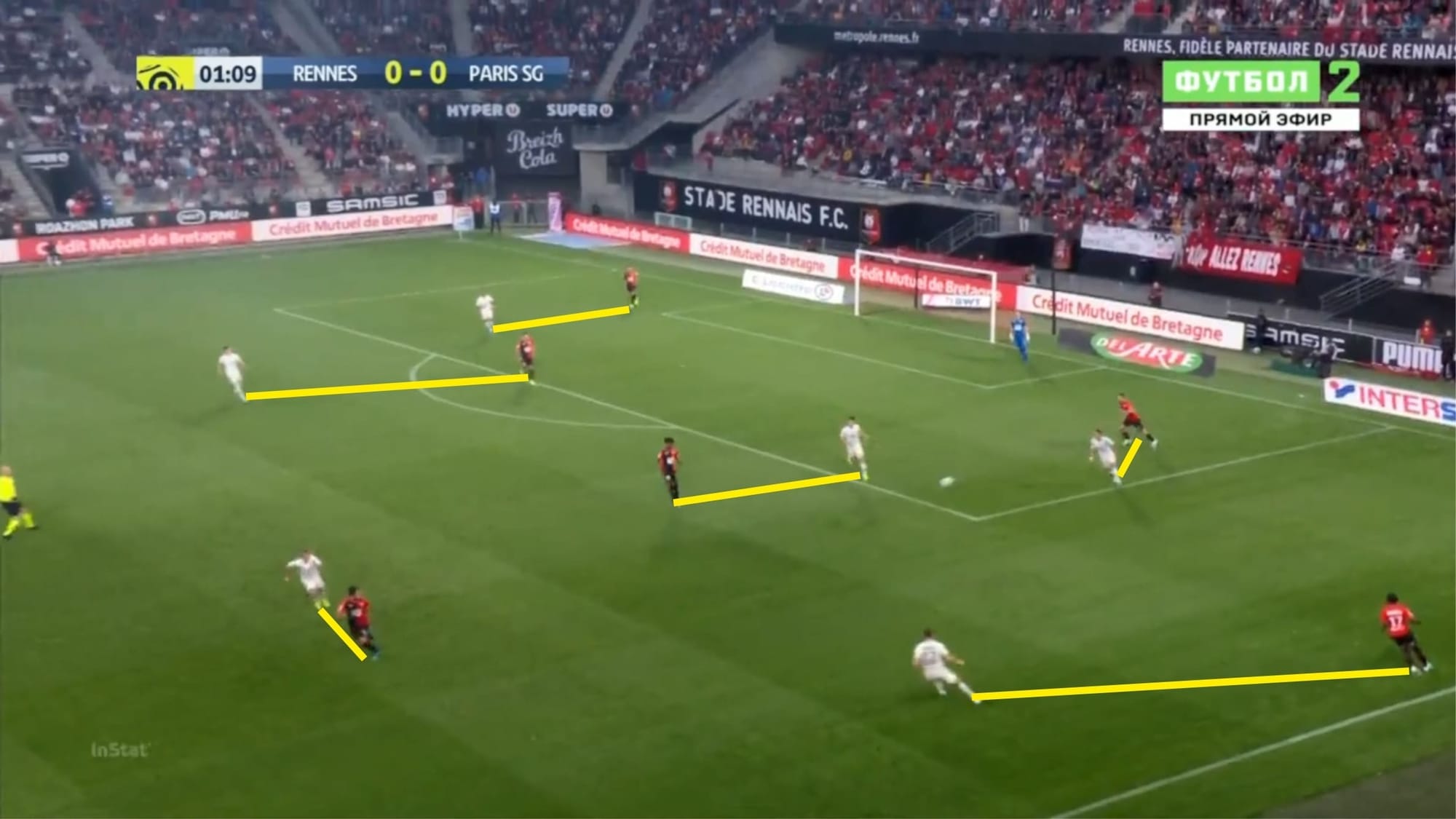
They’d also try to counter-press after losing possession. Again with the same aim of winning the ball high up the pitch as well as preventing a breakaway.
PSG also can be seen trying to create a defensive overload on the flank, trying to isolate the ball-carrier and preventing the ball to progress. However, they mostly didn’t work very well.
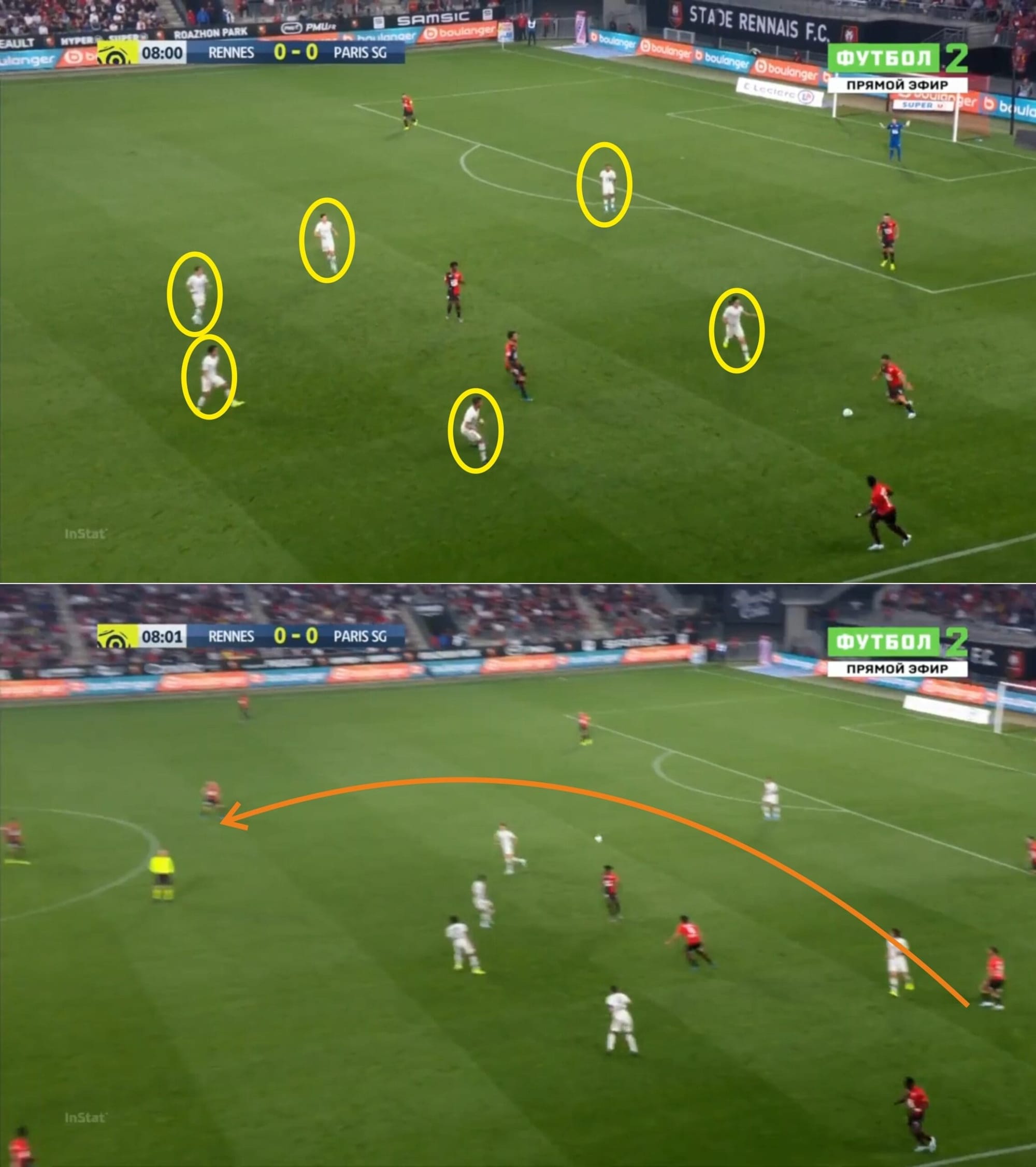
As you can see from the picture above, PSG concentrated a lot of their players on one side of the flank as they tried to create an overload while one player (Cavani) also pressed the ball-carrier to force him into making mistake.
However, despite PSG’s attempts, Jeremy Morel still managed to find a way to exit the pressure via a lofted pass towards Bourigeaud who’s completely free in the middle of the pitch. This was a strange defensive attempt by PSG who was completely unaware of the existence of Bourigeaud at this moment. PSG were numerically superior as you can clearly see in the picture, but the ball-carrier was not completely deprived of passing option. PSG were immediately caught on the break after this rather easy play to exit the pressure by Rennes.
Rennes’s space exploits
Rennes were quite straightforward offensively. While they mostly also tried to play the ball out of defence, they managed to find a lot of space in PSG’s area and they were always very quick to exploit those spaces.
Rennes played mostly using short-medium passes. They exchanged using only one or two touches, moving the ball around at quick pace. They always tried to create passing triangles to exit pressure with players closing down the ball-carrier to provide passing options.
When in the initial build-up phase, youngster Eduardo Camavinga would drop down to link up the play. He was exceptional in this game, helping his team move the ball and progress. His ability to distribute the ball both in short and long-range was outstanding, his fantastic ball control, dribbling, and even body coordination, and agility could clearly be seen as he retained the ball under pressure and even made several progressive dribbling attempts. He showed calmness and composure way beyond his years and he was extremely confident even against a much stronger and experienced PSG side.
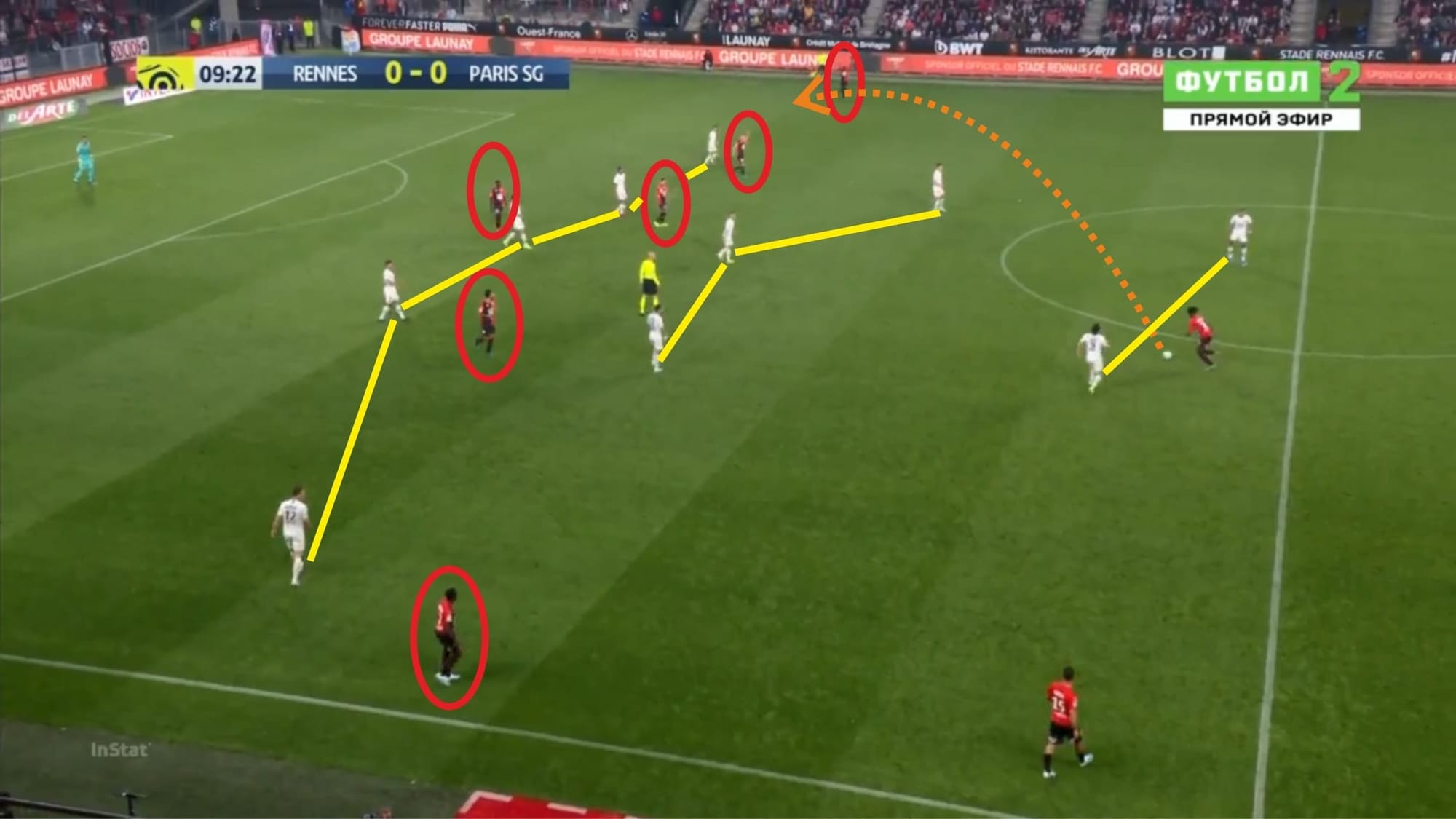
In the picture above, you can see that PSG would shift into a 5-3-2 shape in defence. Though usually blocking high, in this situation Rennes managed to push them deeper into their own half.
Rennes also threw six men upfront when in attacking phase. Just like PSG, the two wing-backs also pushed high and wide to stretch the defence and the two central midfielders (Bourigeaud and Clement Grenier) sat in the half-space.
Del Castillo was allowed more creativity and flexibility in this game as he can be seen covering the areas from the middle third to the final third, from one side to another. Del Castillo sat a lot in the half-space as well and would dribble outwards when he received the ball. Mbaye Niang, was more restricted in this game. He stayed forward and central most of the time, but on certain occasions would also drop and moved a little bit wider into the half-space. However, as he’s the main target inside the box, he’d be expected to always be inside PSG’s box whenever the ball was on the flank.
There were several ways Rennes managed to break through PSG’s defence. Stephan’s side managed to breakthrough centrally and from the flanks a lot of times throughout the game and it seemed surprisingly simple to break through their defence.
Also from the picture above you can see that PSG defended with five men at the back. However, Rennes created numerical superiority by throwing six men upfront. The difference between Rennes and PSG’s defence were that while Rennes’s five-men defence was flat and tends to only mark the opposing player zonally, PSG applied tight man-oriented marking in their defence. When the ball was on one side of the flank and the opposing wing-back dropped to link up, PSG’s wing-back would leave his space and follow him. PSG’s defence would also shift a little bit, forming a four-man defence for a little while.
Rennes managed to exploit this by switching flanks often, mostly using medium-long range diagonal passes. Damien Da Silva, Jeremy Gelin, Morel, and Camavinga were the main distributor of these diagonal passes and they were not well defended against. As mentioned previously in this tactical analysis as well, Rennes tended to move the ball quickly. This gave PSG only a very little time to shift and reposition their defence to defend against Rennes’ attacks.
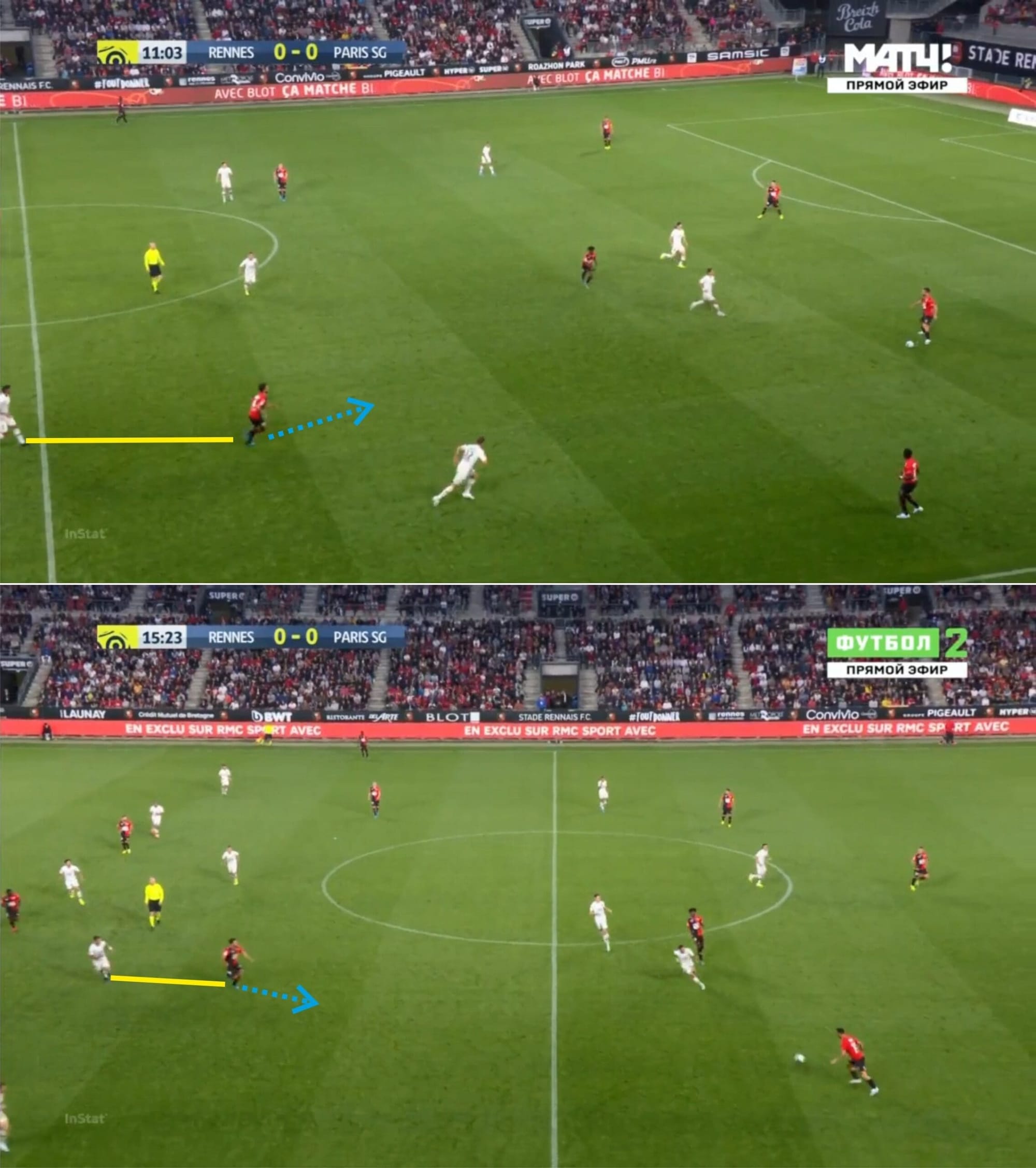
Rennes could also break through centrally several times in the game. Again, this was mostly due to PSG’s man-oriented marking and the defenders’ tendency to move out of position and follow their man as shown in the picture above.
In the second picture, Rennes actually successfully create a central breakthrough.
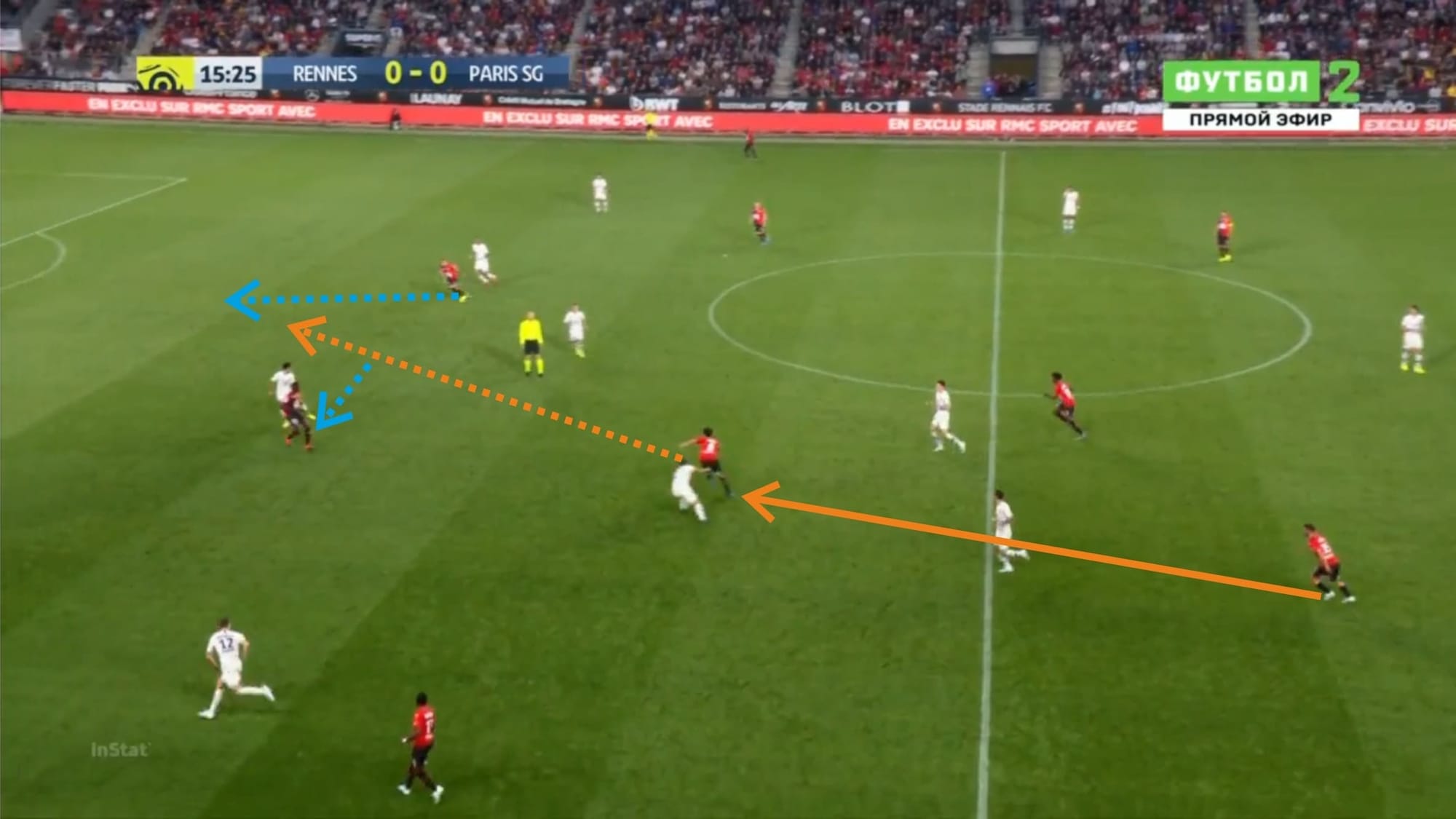
Grenier dropped to link up, dragging Silva out of position. He received the ball from Morel, moving the ball to his left with his first touch. At this point, Silva lost his balance and was beaten by Grenier. Marquinhos marked Niang, who left his post in the centre to move into the half-space on the left. This split the two PSG defenders and opened up space in the middle which was exploited by Del Castillo who saw what was happening and made the run. Grenier picked Del Castillo up who was quicker to the ball than Diallo and was now left free in the final third. Lucky for PSG, Diallo managed to catch up with Del Castillo and made the last-ditch tackle to block the forward’s shot.
Conclusion
It was a cagey affair early in the game, but both teams seemed to be much more open in their play after Cavani’s goal to break the deadlock.
Despite dominating the possession, PSG couldn’t find a way past the resilient Rennes defence. And Rennes with their effectiveness and efficiency upfront, showed that you don’t need to have most of the possession in order to dominate a game.
Rennes were clearly superior tactically. Stephan’s genius tactics successfully neutralized PSG’s aggressive attacks and in turn exploited their defensive weakness as well.

If you love tactical analysis, then you’ll love the digital magazines from totalfootballanalysis.com – a guaranteed 100+ pages of pure tactical analysis covering topics from the Premier League, Serie A, La Liga, Bundesliga and many, many more. Buy your copy of the August issue for just ₤4.99 here.

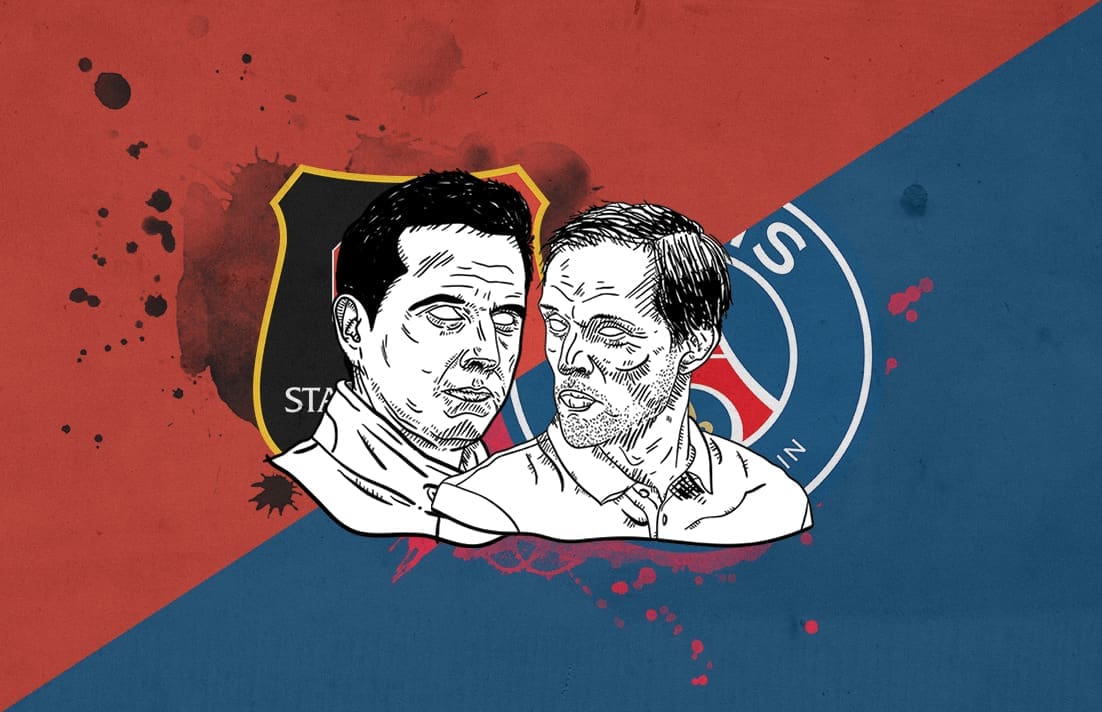



Comments